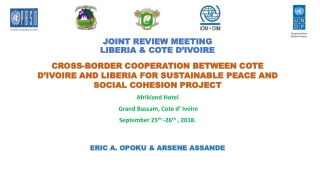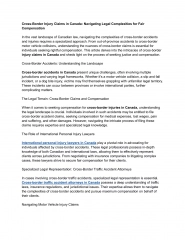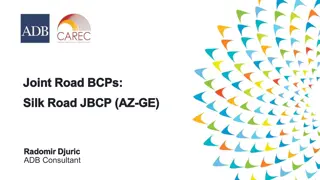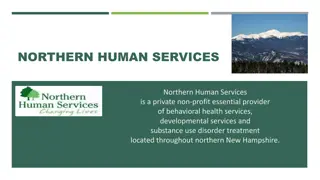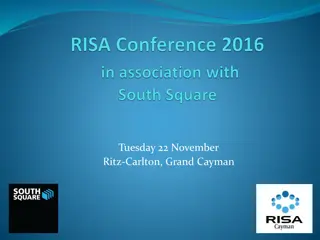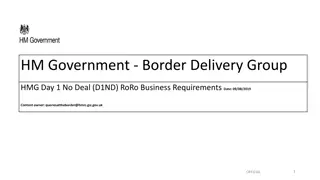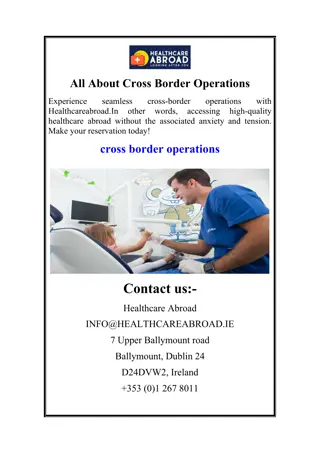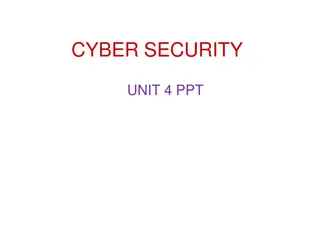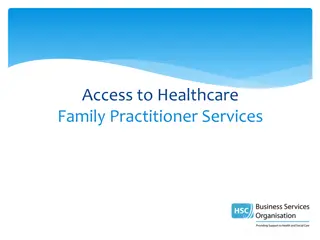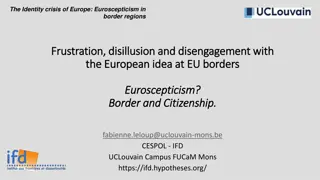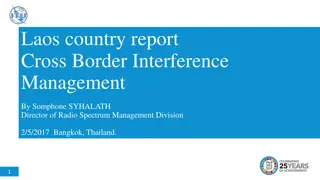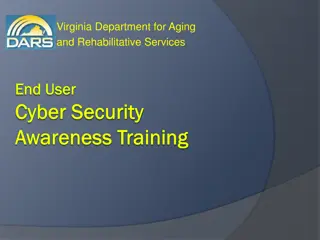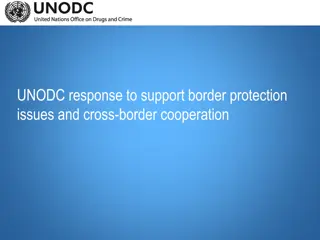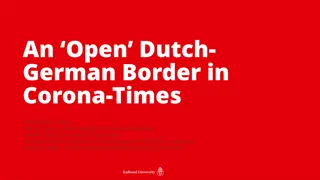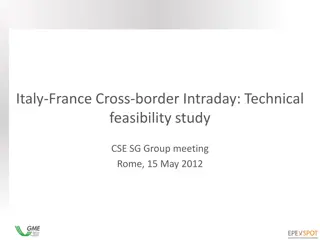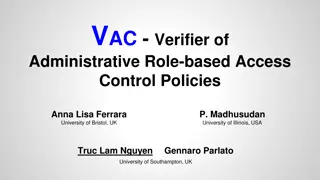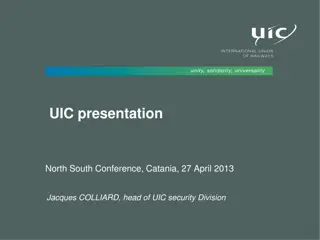CPIS434 - Information Security Policies & Strategies at Northern Border University
Explore IS policies and strategies in CPIS434 at Northern Border University under the Ministry of Higher Education in the Kingdom of Saudi Arabia, led by Mrs. Nuha J. Khediri for the academic year 1444. Delve into IT governance and security measures.
Download Presentation

Please find below an Image/Link to download the presentation.
The content on the website is provided AS IS for your information and personal use only. It may not be sold, licensed, or shared on other websites without obtaining consent from the author.If you encounter any issues during the download, it is possible that the publisher has removed the file from their server.
You are allowed to download the files provided on this website for personal or commercial use, subject to the condition that they are used lawfully. All files are the property of their respective owners.
The content on the website is provided AS IS for your information and personal use only. It may not be sold, licensed, or shared on other websites without obtaining consent from the author.
E N D
Presentation Transcript
IS Policies & Strategies CPIS434 Kingdom of Saudi Arabia Ministry of Higher Education Northern Border University Faculty of Computing & Information Technology Mrs. Nuha J. KHEDIRI Nuha.khediri@nbu.edu.sa academic year 1444 Mrs Nuha Khediri 1
IS Policies & Strategies The Contents 1. The Information Systems Strategy Triangle 2. Strategic Use of Information Resources 3. Organizational Impacts of Information Systems Use 4. Information Technology and the Design of Work 5. Information Technology and Changing Business Processes 6. Information Systems Sourcing academic year 1444 Mrs Nuha Khediri 2 CPIS434
Introduction THE CASE FOR PARTICIPATING IN DECISIONS ABOUT INFORMATION SYSTEMS 3 Mrs Nuha Khediri CPIS434
People and Technology People and Technology work together. Technology is critical. Workers rely heavily on technology. Managers must know how to mesh both. Examine long-term and short-term consequences. Manage change carefully. Technology changes rapidly. 4 Mrs Nuha Khediri CPIS434
WHAT IF A MANAGER DOESNT PARTICIPATE? 5 Mrs Nuha Khediri CPIS434
Business Goals & Organizational Systems IS must support business goals. It is not an end but a means to an end. Support and strategic focus. IT must support organizational systems The people, work processes, and structure. 6 Mrs Nuha Khediri CPIS434
WHAT SKILLS ARE NEEDED TO PARTICIPATE EFFECTIVELY IN INFORMATION TECHNOLOGY DECISIONS? 7 Mrs Nuha Khediri CPIS434
BASIC ASSUMPTIONS Managers must know about both using and managing information. Managers must be knowledgeable participants in IS decisions. The general manager must have a basic understanding of the business and technology issues related to IS. Technology of today is different from the technology of yesterday. 8 Mrs Nuha Khediri CPIS434
The role of the general manager and IS manager are distinct. The GM must have a basic understanding of IS to make decisions that implications for the business. The IS manager must have general business knowledge and a more in depth knowledge of IS to support its function. may have significant 9 Mrs Nuha Khediri CPIS434
Management Assumptions Four key activities of the classic view of management (Fig I.3). Planning Organizing Leading Controlling Classic view is seen as more of a tactical approach to management. 10 Mrs Nuha Khediri CPIS434
Functional View Functional View of the business Based on the functions people perform. Information flows vertically in the organization. Sometimes information organization. Accounting, Operations, Marketing, Sales and Support. Executive Management receives the information and distributes as need arrives. See Figure 1 flows across the 11 Mrs Nuha Khediri CPIS434
Figure 1. Hierarchical View of the firm. 12 Mrs Nuha Khediri CPIS434
Process View This model sees the business by the processes it performs to achieve its goals. Porter describes business in terms of its primary and support activities. Primary inbound and outbound logistics, operations, marketing and sales. Support HR, technology, infrastructure. Activities are linked together to form a chain the value chain (fig 2). procurement, 13 Mrs Nuha Khediri CPIS434
Figure 2 Process View of the Firm: The Value Chain 14 Mrs Nuha Khediri CPIS434
Information Hierarchy Data, Information, and Knowledge are not interchangeable terms. Data set of specific observations. Information data endowed with relevance and purpose. Knowledge - information synthesized and contextualized to provide value. objective facts or that has been 15 Mrs Nuha Khediri CPIS434
Data Information Knowledge Definition Simple Observations of the sate of the world Data endowed with relevance and purpose Info from the human mind (includes reflection, etc) Characteristic Easily structured captured transferred Often quantified Mere facts Requires unit of analysis Data that has been processed Human mediation necessary Daily inventory report of items below economic order quality levels sent to inventory manager (IM) Hard to structure Difficult to capture on machines Often tacit Hard to transfer Example Daily inventory reports of all inventory items sent to CEO of large manufacturing company IM knows which items need to be reordered in light of related potential problems 16 Mrs Nuha Khediri CPIS434
System Hierarchy Information systems are comprised of three main elements: Technology People Process Infrastructure everything that supports the flow of processing information Hardware, software, data, and components. Architecture strategy implicit in these components. 17 Mrs Nuha Khediri CPIS434
Management Information Systems People Technology Process Figure 3. System Hierarchy 18 Mrs Nuha Khediri CPIS434
Summary Business managers must be involved in information decisions. Technology is ubiquitous. IT is a critical resource. People and Technology work together. Certain key skills are needed. Data, Information, and Knowledge are distinct. 19 Mrs Nuha Khediri CPIS434
Chapter 1 The Information System Strategy Triangle Mrs Nuha Khediri 3 CPIS434
IS Strategy Triangle Business Strategy Organizational Strategy Information Strategy IS strategy can itself affect and is affected by changes in a firm s business and organizational strategies Chapter 1 Mrs Nuha Khediri 4 CPIS434
Overview of Business Strategy Framework A strategy is a coordinated set of actions to fulfill objectives, purposes, and goals. Strategy starts with a mission. A mission is a clear and compelling statement that unifies an organization s effort and describes what the firm is all about. Exp: IBM, Dell, and Apple are all in the computer industry, they view their missions quite differently: IBM says it focuses on services and solutions, Dell on customer experiences, and Apple on innovation and personal computing experience. Chapter 1 Mrs Nuha Khediri 5 CPIS434
Overview of Business Strategy Framework A business strategy is a plan articulating where a business seeks to go and how it expects to get there. It is the means by which a business communicates its goals Company Mission statement IBM At IBM, we strive to lead in the creation, development, and manufacture of the industry s most advanced information technologies, including computer systems, software, networking microelectronics. We translate these advanced technologies into value for our customers through our professional solutions and services businesses worldwide systems, storage devices, and Dell Dell s mission is to be the most successful computer company in the world at delivering the best customer experience in markets we serve Apple Apple ignited the personal computer revolution in the 1970s with the Apple II and reinvented the personal computer in the 1980s with the Macintosh. Apple is committed to bringing the best personal computing experience to students, educators, creative professionals, and consumers around the world through its innovative hardware, software, and Internet offerings Chapter 1 Mrs Nuha Khediri 6 CPIS434
The Generic Strategies Framework Three strategies for achieving competitive advantage. Cost leadership results when the organization aims to be the lowest-cost producer in the marketplace. differentiation, the organization qualifies its product or service in a way that allows it to appear unique in the marketplace. Focus allows an organization to limit its scope to a narrower segment of the market and tailor its offerings to that group of customers. Chapter 1 Mrs Nuha Khediri 7 CPIS434
The Generic Strategies Framework Differentiation strategy include: The shareholder value model suggests that customers buy products or services from an organization to have access to its unique knowledge The unlimited resources model utilizes a large base of resources that allows an organization to outlast competitors by practicing a differentiation strategy Chapter 1 Mrs Nuha Khediri 8 CPIS434
Overview of Organizational Strategies Organizational strategy: is a plan that answers the question: How will the company organize to achieve its goals and implement its business strategy? A simple framework for understanding the design of an organization is the business diamond The business diamond identifies the crucial components of an organization s plan as: (1) business processes, (2) values & beliefs, (3) management & measurement systems (4) tasks & structures Chapter 1 Mrs Nuha Khediri 9 CPIS434
Overview of Organizational Strategies Business diamond model on jetBlue case Process Every morning the CEO reviews details about the previous day s flights with the operations team, and each process is carefully inspected to see if it can be made more efficient Values & beliefs The manager uses a visible, one-on-one leadership style that allows him to interact freely with the employees Measurement a set of metrics for a variety of operations. For example, the time it takes to deliver bags to the passengers is measured with a goal of delivering them no later than 20 minutes after the plane has reached the gate Tasks Everyone sets up and helps. When a plane lands, every employee on the plane from the stewardess, to the chairman, will pitch in to clean the plane and get it ready for the next set of passengers Chapter 1 Mrs Nuha Khediri 10 CPIS434
Overview of IS Strategy Information System strategy is the plan an organization uses to provide information services. IS allow a company to implement its business strategy Information System strategy matrix give the manager a high- level view of the relation between the four IS infrastructure components and the other resource considerations that are key to IS strategy. Chapter 1 Mrs Nuha Khediri 11 CPIS434
Overview of IS Strategy matrix Chapter 1 Mrs Nuha Khediri 12 CPIS434
Strategic Relationships Organizational strategy and information strategy must complement each other. If a decision is made to change one corner of the triangle, it is necessary to evaluate the other two corners to ensure that balance is preserved. Changing business strategy without thinking through the effects on the organizational and IS strategies will cause the business to struggle until balance is restored. Likewise, changing IS or the organization alone will cause an imbalance. Chapter 1 Mrs Nuha Khediri 13 CPIS434
Chapter 2 Strategic Use Of Information Resources Mrs Nuha Khediri 14 CPIS434
Evolution of Information Resources Mission statements of computer companies Era I 1960s Era II 1970s Era III 1980s Era IV 1990s Era V 2000+ Era VI 2010+ Primary role of IT Efficiency Automate existing paper-based processes Effectiveness Solve problems and create opportunities Strategic Increase individual and group effectiveness Strategic Value creation Value extension Transform industry/ organization Create community and social business Creating relationships Create collaborative partnerships Justify IT expenditures ROI: Increasing productivity and better decision quality Organization/ group Competitive position Competitive position Adding value return investment on Target of systems Organization Individual manager/ group Business processes ecosystem Customer/ supplier ecosystem Customer/ employee/ supplier ecosystem People driven (or relationship driven) Information models Application specific Data driven User driven Business driven Knowledge driven Chapter 2 Mrs Nuha Khediri 16 CPIS434
Information Resources Mission statements of computer companies Era I 1960s Era II 1970s Era III 1980s Era IV 1990s Era V 2000+ Era VI 2010+ Dominant technology Mainframe, centralized intelligence Minicomputer, mostly centralized intelligence Microcomputer, decentralized intelligence Client Server, distributed intelligence Internet, global ubiquitous intelligence Social platforms, social networks, mobile, cloud Plentitude Basis of value Scarcity Scarcity Scarcity Plentitude Plentitude Underlying economics Economics of information bundled with economics of things Economics of information bundled with economics of things Economics of information bundled with economics of things Economics of information separated from economics of things Economics of information separated from economics of things Economics of relationships bundled with economics of information Chapter 2 Mrs Nuha Khediri 16 CPIS434
Information Resources Managers need to combine all of the firm s available resources. Internal resources: Financial, production, human, and information resources. External resources: The Internet and various global opportunities. Information Resources are the available data, technology, people, and processes available to perform business processes and tasks. Chapter 2 Mrs Nuha Khediri 15 CPIS434
Information Resources Information resources can be either assetsor capabilities. IT Asset: anything, tangible or intangible, that can be used by a firm in its processes for creating, producing, and/or offering its products (goods or services) IT Capability: is something that is learned or developed over time for the firm to create, produce, or offer its products. An IT capability makes it possible for a firm to use its IT assets effectively Chapter 2 Mrs Nuha Khediri 16 CPIS434
Information Resources Categories of IT Assest IS infrastructure: Includes data, technology, people, and processes. Provides the foundation for delivery of a firm s products or services. Information repository : Logically-related data that is captured, organized, and retrievable by the firm. Designed to improve the firm s efficiency. Web 2.0 space includes resources used but not owned by the firm (e.g., eBay, Facebook, LinkedIn, etc.). Available as a service such as Internet-based software (Software as a Service, or SAAS). Managers can manage customer information with an externally based IT resource. Managers can find expertise or an entire network of individuals ready to participate in the innovation processes with relatively little capital or expense (e.g., Facebook, LinkedIn). Chapter 2 Mrs Nuha Khediri 16 CPIS434
Information Resources Categories of IT Capabilities Technical skills applied to designing, developing, and implementing IS. IT management skills critical for managing IT function and IT projects. Relationship skills can be either externally-focused or span across departments. Committing and developing information resources requires substantial financial resources. Chapter 2 Mrs Nuha Khediri 16 CPIS434
Information Resources Type of Information Resource Definition Example Anything that can be used by a firm in its processes for creating, producing, and/or offering its products (goods or services). IT Asset Base foundation of the IT portfolio shared through the firm Hardware, software, network, data components, proprietary technology, web-based services IS infrastructure Data that is logically related and organized in a structured form accessible and usable for decision making purposes. Critical information about customers that can be used to gain strategic advantage. Much of this information is increasingly available on the web. Information repository Something that is learned or developed over time in order for the firm to create, produce, or offer its products in IT assets. IT Capability Ability applied to designing, developing, and implementing information systems Ability to manage IT function and IT projects Proficiency in systems analysis and design; programming skills Technical skill Being knowledgeable about business processes and managing systems to support them; evaluating technology options; envisioning creative IS solutions to business problems IT management skills Ability of IS specialists to work with parties outside the IS department. Spanning: having a good relationship between IT and business managers Externally-focused: having a good relationship with an outsourcing vendor Relationship skills Chapter 2 Mrs Nuha Khediri 16 CPIS434
Information Resources Managers must take multiple views of the strategic landscape: First view Porter s five competitive forces model. Second view Porter s value chain. Third view types of IS resources needed to gain competitive advantage. Chapter 2 Mrs Nuha Khediri 16 CPIS434
Using Information Resources to Influence Competitive Forces Chapter 2 Mrs Nuha Khediri 17 CPIS434
Porters five forces model Porter s five forces model shows the major forces that shape the competitive environment of the firm 1. Threat of New Entrants: new firms that may enter a companies market. Bargaining Power of Buyers: the ability of buyers to use their market power to decrease a firm s competitive position Bargaining Power of Suppliers: the ability suppliers of the inputs of a product or service to lower a firm s competitive position Threat of Substitutes: providers of equivalent or superior alternative products Industry Competitors: current competitors for the same product. 2. 3. 4. 5. Chapter 2 Mrs Nuha Khediri 17-1 CPIS434
Porters five forces model Competitive Force IT Influence on Competitive Force Threat of New Entrants Can be lowered if there are barriers to entry. Sometimes IS can be used to create barriers to entry Bargaining Power of Buyers Can be high if it s easy to switch. Switching costs are increased by giving buyers things they value in exchange such as lower costs or useful information Bargaining Power of Suppliers Forces is strongest when there are few firms to choose from, quality is inputs is crucial or the volume of purchases is insignificant to the supplier Threat of Substitute Products Depends on buyers willingness to substitute and the level of switching costs buyer s face Industrial Competitors Rivalry is high when it is expensive to leave and industry, the industry s growth rate is declining, or products have lost differentiation Chapter 2 Mrs Nuha Khediri 17-2 CPIS434
Porters Value Chain Model The value chain model addresses the activities that create, deliver, and support a company s product or service Two types of activities: primary and support Primary activities relate directly to the value created in a product or service. Support activities make it possible for the primary activities to exist and remain coordinated. Chapter 2 Mrs Nuha Khediri 18 CPIS434
Porters Value Chain Model Chapter 2 Mrs Nuha Khediri 18 CPIS434
Porters Value Chain Model Primary activities: relate directly to the value created in a product or service Support activities: make it possible for the primary activities to exist and remain coordinated Each activity may affect how other activities are performed Chapter 2 Mrs Nuha Khediri 19 CPIS434
Customer Relationship Management Customer relationship management (CRM) is a natural extension of applying the value chain model to customers. CRM is a coordinated set of activities designed to learn more about customers needs and behaviors to develop stronger relationships with them and to enhance their value chains CRM consists of technological components and a process that brings together many pieces of information about customers, sales, marketing effectiveness, responsiveness, and market trends Chapter 2 Mrs Nuha Khediri 20 CPIS434
Supply Chain Management Supply chain management (SCM) is an approach that improves the way a company finds raw components it needs to make a product or service, manufactures that product or service, and delivers it to customers. Supply chain management (SCM) is one example of a mechanism for creating strategic alliances. Chapter 2 Mrs Nuha Khediri 21 CPIS434
Resources to attain competitive advantages - A resource is considered valuable when it enables the firm to become more efficient or effective. - A resource is rare when other firms do not possess it. Stakes or resources required just to be in the business (e.g., banks and ATMs). Initially rare and valuable resources were the communities many companies implemented using social IT. These communities were a valuable resource for the firms that sponsored them, and only a few existed. Chapter 2 Mrs Nuha Khediri 19 CPIS434
Resources to attain competitive advantages Many firms that invested in systems learned that gaining a competitive automatically mean that you can sustain it over the long term. Need to continue to innovate and to protect against resource imitation, substitution, or transfer. Technical knowledge, especially relating to the firm s operation; a gung-ho managerial experience in the firm s environment is less easy to obtain and is considered harder to transfer to other firms. advantage does not company culture; and Chapter 2 Mrs Nuha Khediri 19 CPIS434
Chapter 3 Organizational Impacts of Information Systems Use Mrs Nuha Khediri 22 CPIS434


